Sat, September 24, 2022

Hundreds of expatriate Iranians rallied in Paris and other European cities on Saturday to denounce Iran's crackdown on protests following the death of Mahsa Amini after her arrest by morality police.
The protesters gathered in the central Place du Chatelet in the French capital and chanted slogans against supreme leader Ayatollah Ali Khamenei and also urged French President Emmanuel Macron to halt negotiations with Iran.
"Khamenei get out of Iran!", "Macron enough silence!" and "Death to the Islamic republic" were among the slogans shouted by the demonstrators in French and Persian, an AFP reporter said.
The protesters also sung in Persian the Italian protest song "Bella Ciao (Goodbye Beautiful)" which has become popular with supporters of the movement.
They also repeated the viral Persian chants used by protesters inside Iran such as "zan, zendegi, azadi!" (woman, life, freedom!) and also its Kurdish equivalent "jin, jiyan, azadi!" as Amini, also known as Jhina Amini, was Kurdish.
In other protests, Iranian women in Athens cut their hair in a gesture of solidarity with Amini, brandishing placards reading "say her name!".

Demonstrators on Sergels torg in the centre of the Swedish capital Stockholm also cut their hair while another group outside the Swedish parliament held up pictures of those killed.
Iran says that 35 people have died in the protests that erupted after the death of Amini but activists say that the number is now over 50 and likely even higher.
Demonstrators in Paris expressed fury that Macron had met and shaken hands with Iranian President Ebrahim Raisi on the sidelines of the UN General Assembly in New York this week as Paris seeks to keep the 2015 deal on Tehran's nuclear programme alive.
"How can you shake the hands of someone who has committed a crime against humanity?" read a placard brandished by the protesters referring to Raisi's alleged involvement in the 1988 mass executions of political prisoners in Iran.
"The anger has caught fire and the flames will be impossible to extinguish," said Mahtab Ghorbani, an exiled poet and writer who lives in France.
"Those who do not speak up will be held responsible and we demand that France stops the negotiations (on the nuclear issue) and closes the Iranian embassy in Paris," she said.
The protesters are planning to hold a second demonstration on Sunday where they intend to march on the Iranian embassy in Paris.
sjw/gw
AFP -
As deadly protests flare in Iran after the death of 22-year-old Kurdish woman Mahsa Amini, Iranians who have crossed into neighbouring Iraq's Kurdistan region for work speak of repression back home.

Map of Iran showing main locations of recent protests© Julia Han JANICKI

Iranian Kurdish men working in neighbouring Iraq's northern Kurdistan region: the two areas have close ties© SAFIN HAMED
Amini died after her arrest by Iran's feared morality police for allegedly breaching the country's strict dress code for women.
News of her death on September 16 sparked widespread outrage and triggered rare demonstrations.
"The protests begin in the evening and continue into the middle of the night," said Kawa Krimi, 50, who had come to Iraq from Iran to visit relatives.

A picture obtained by AFP outside Iran on September 21 shows Iranian demonstrators burning a rubbish bin in the capital Tehran during a protest for Mahsa Amini following her death© -
On streets in Iran, young people have set fire to pictures of Iran's supreme leader Ayatollah Ali Khamenei amid shouts of "death to the dictator".
Protests have provoked a deadly backlash by security forces, with the authorities trying to restrict internet access to snuff out coverage.

Iranians cross into Iraqi Kurdistan seeking work, amid economic sanctions at home imposed by the United States© SAFIN HAMED
Iranians who cross into Iraq for work or to see relatives say they are still too scared of repercussions at home to speak openly.

Kurds in Arbil, the capital of Iraqi Kurdistan, protest against Amini's death on Saturday© SAFIN HAMED
Krimi, using an alias, said that in his home town of Marivan in western Iran a "general strike" had begun on Friday.
"All the shops and markets are closed," he said.
Some said that while Amini's death was a trigger, a long-running economic crisis and a wider climate of repression fed into the explosion of anger.
- Protests spread to Iraq -
The official death toll from the protests stands at 35, state media reported late Friday.
Norway-based organisation Iran Human Rights on Friday put the toll at 50 people.
Krimi said protests are ongoing in Marivan, despite a wave of arrests and the use of live rounds by security forces, wounding one boy in the head.
Iran's western Kurdish areas -- where Amini was from -- and Iraq's northern autonomous region of Kurdistan have close ties.
People speak the same language, and many have relatives either side of the border.
When Iranian Kurds speak of Amini, they use her Kurdish first name, Jhina.
In Marivan, protesters "face off" against the security forces, said 27-year-old Kochar, another Iranian recently arrived in Iraq.
"Most of the protesters are young men and women," added Kochar, a labourer loading tomatoes into a truck.
They "hold up pictures of Jhina, shouting slogans against the Islamic republic in front of the governor's offices", he said.
Kochar said shops had shut earlier in the week in "protest at the death of Jhina and the politics of the Islamic republic".
In Arbil, the capital of Iraqi Kurdistan, people took to the streets on Saturday to add their voices to the anger over Amini's death.
They chanted in Kurdish, "Women, life, freedom!" and called for the fall of Iran's "dictatorship", according to an AFP photographer. Some burned the Iranian national flag.
- 'Sticks and stones' -
Kochar, like others, says the economic situation in Iran is tough, due to years of biting sanctions imposed by the United States after then president Donald Trump withdrew from a multilateral nuclear deal with Tehran in 2018.
He plans to work for a month in Iraq, where he can earn double the money for the same labour as at home.
"In our regions, there is no work," Kochar said. "And even if we do find it, it pays at half the rate you can get in Iraqi Kurdistan."
Azad Husseini, a carpenter working in Iraq, said he had not taken part in protests but had been swept up in a demonstration when back home in the western Iranian city of Baneh.
Protesters were shouting "death to the dictator" and "life and liberty", he said, adding that they also burned pictures of Khamenei.
Police fired tear gas and live rounds to disperse protesters carrying nothing more than "sticks and stones", he said.
Husseini said that while the death of Amini had been a trigger for protests, anger was rooted in wider grievances.
"The difficult economic situation in Iran... the repression of freedoms, particularly those of women, and the rights of the Iranian people led to an implosion of the situation," he said.
"I don't think the protests in Iranian cities are going to end anytime soon."
str-tgg/gde/dwo/hc
Death toll doubles, hundreds arrested in 'harrowing' Iran protest crackdown
AFP , Saturday 24 Sep 2022
The official death toll has nearly doubled to 35 in a crackdown by Iran's security forces on more than a week of protests that erupted after the death of a young woman in custody.
Hundreds of angry demonstrators have been arrested with crowds taking to the streets of major cities across Iran for eight straight nights since the death of Mahsa Amini.
The 22-year-old Kurd was pronounced dead after spending three days in a coma following her arrest by Iran's feared morality police for wearing the hijab headscarf in an "improper" way.
State television said the number of deaths in "recent riots" had risen to 35, up from 17 previously, including at least five security personnel.
Sweeping arrests have been reported, with the police chief in the northwestern province of Guilan announcing Saturday "the arrest of 739 rioters including 60 women" in his region alone, Tasnim news agency said.
Protests were held around the Islamic republic on Friday night, with online videos showing some turning violent, including in Tehran.
Footage showed security forces firing what appeared to be live ammunition at unarmed demonstrators in the northwestern cities of Piranshahr, Mahabad and Urmia.
In a video shared by the Oslo-based Iran Human Rights non-governmental organisation, a uniformed member of the security forces is seen shooting an AK-47 assault rifle at protesters in Shahr-e Rey, on Tehran's southern outskirts.
Security forces have carried out a wave of arrests of activists and journalists, with Sherif Mansour of US-based media watchdog the Committee to Protect Journalists (CPJ) reporting 11 had been detained since Monday.
They include Niloufar Hamedi of the reformist newspaper Shargh, who reported on Amini's death.
Internet blackout
Elsewhere, the Norway-based Kurdish rights group Hengaw said protesters "took control" of parts of the city of Oshnaviyeh, in West Azerbaijan province.
Images showed protesters walking freely with their hands aloft in triumph, but Hengaw acknowledged this could be "temporary" and expressed fears of a new crackdown there.
Amnesty International warned of "the risk of further bloodshed amid a deliberately imposed internet blackout".
The London-based human rights group said evidence it gathered from 20 cities across Iran pointed to "a harrowing pattern of Iranian security forces deliberately and unlawfully firing live ammunition at protesters".
In its statement, Amnesty said security forces had shot dead at least 19 people on Wednesday night alone, including at least three children.
Thousands of people marched through Tehran during a pro-hijab rally Friday, paying tribute to security forces who have moved to quell a week of protests by what media called "conspirators".
Demonstrations in support of the security forces also took place in the cities of Ahvaz, Isfahan, Qom and Tabriz.
Amini died following her arrest by Iran's morality police, a unit responsible for enforcing the Islamic republic's strict dress code for women.
Activists said she suffered a blow to the head in custody but this has not been confirmed by the Iranian authorities, who have opened an investigation.
Iranian women have burnt their headscarves and symbolically cut their hair in protest at the strict dress code, echoed in solidarity demonstrations from New York to Istanbul and Brussels to Santiago, Chile.
'Toothless'
Iran's Interior Minister Ahmad Vahidi insisted Amini had not been beaten.
"Reports from oversight bodies were received, witnesses were interviewed, videos were reviewed, forensic opinions were obtained and it was found that there had been no beating," he said.
The minister said Iran was investigating Amini's death, adding "we must wait for the final opinion of the medical examiner, which takes time".
Amnesty dismissed the Iranian probe and called on the world to take "meaningful action" against the bloody crackdown.
"UN member states must go beyond toothless statements, hear the cries for justice from victims and human rights defenders in Iran and urgently set up an independent UN investigative mechanism," said Heba Morayef, its director for the Middle East and North Africa.
Iran has imposed tough restrictions on the use of the internet in a bid to hamper protesters gathering and stop the flow of images of the backlash from reaching the outside world.
The United States announced Friday it was easing export restrictions on Iran to expand internet services.
The new measures would "help counter the Iranian government's efforts to surveil and censor its citizens," said Secretary of State Antony Blinken.
At least 50 killed in 8 days of protests ignited by woman’s death while in custody of morality police; thousands gather at government counter-demonstrations
By AGENCIES
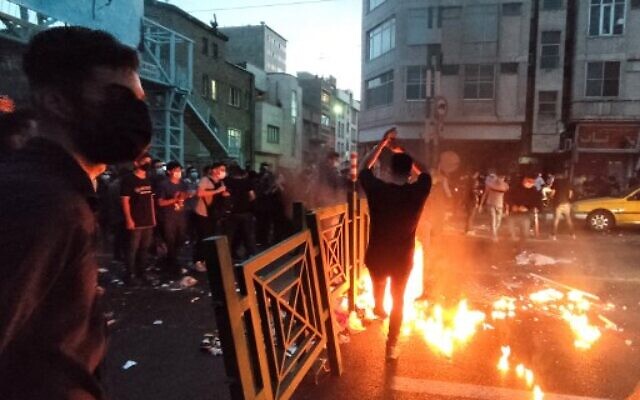
A picture obtained by AFP outside Iran on September 21, 2022, shows Iranian demonstrators taking to the streets of the capital Tehran during a protest for Mahsa Amini, days after she died in police custody. (AFP)
Protests flared in Iran for an eighth straight night on Friday over the death of a young woman arrested by morality police, verified social media posts showed, hours after counter-demonstrations mobilized by authorities.
At least 50 people have been killed by security forces in the anti-government protests, according to Iran Human Rights, an Oslo-based organization.
The street violence, which the rights group said has spread to 80 towns and cities, was triggered by the death of Mahsa Amini, a 22-year-old Kurdish Iranian who had spent three days in a coma after being detained by the morality police in Tehran.
Verified footage spread on social media showed large crowds of protesters gathering in several neighborhoods of the capital Tehran after dark, just hours after the government-backed rallies dispersed.
Some were confronted by armed anti-riot police or militia.
Iran has imposed tough restrictions on the use of the internet in a bid to hamper protesters gathering and stop the flow of images of the backlash from reaching the outside world.
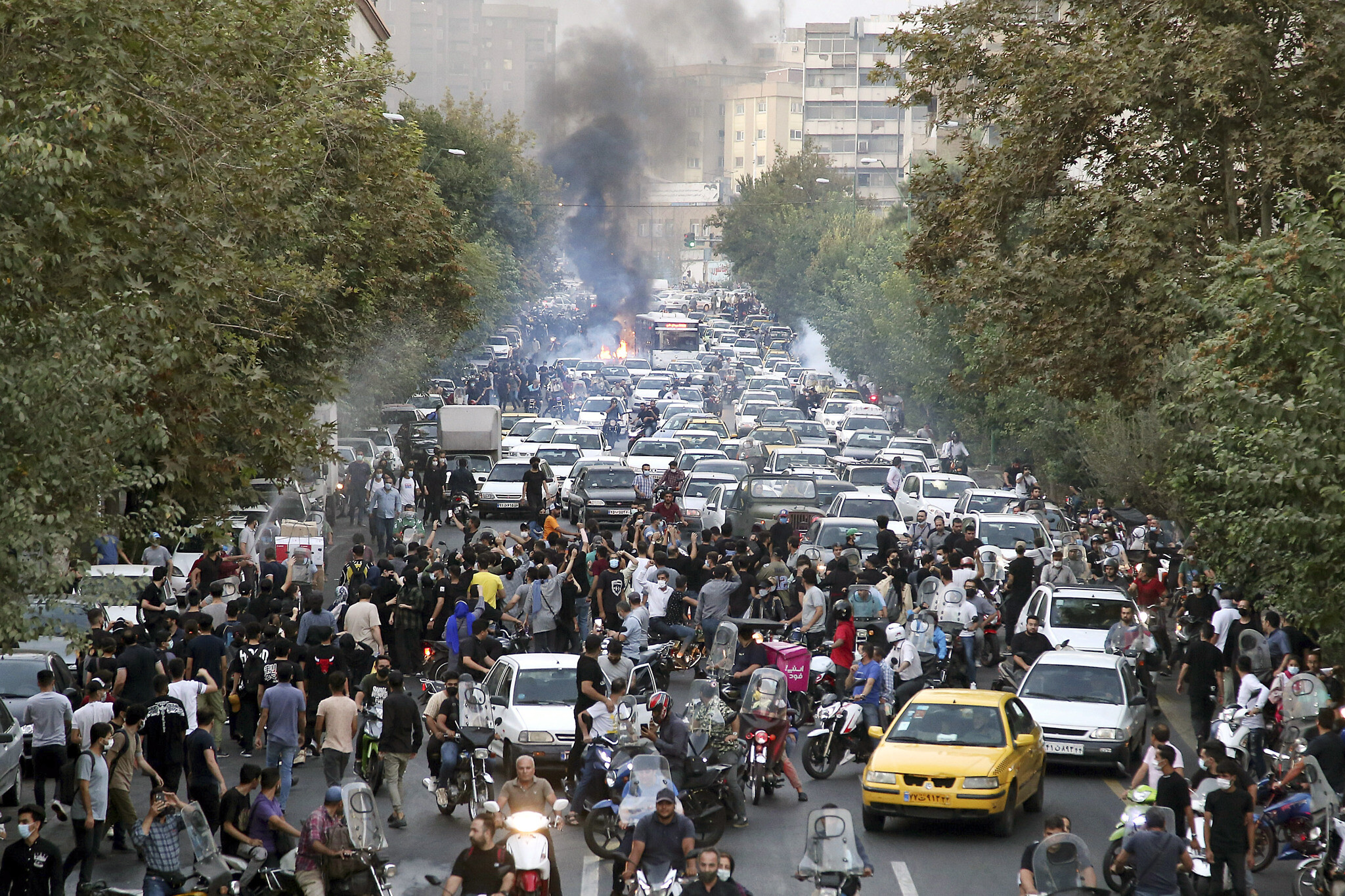
In this photo taken by an individual not employed by the Associated Press and obtained by the AP outside Iran, protesters chant slogans during a protest over the death of a woman who was detained by the morality police, in downtown Tehran, Iran, September 21, 2022. (AP)
The United States announced Friday it was easing export restrictions on Iran to expand internet services, days after SpaceX owner Elon Musk said he would seek an exemption from sanctions to offer his company’s Starlink satellite service in Iran.
The new US measures will “help counter the Iranian government’s efforts to surveil and censor its citizens,” said Secretary of State Antony Blinken.
“It is clear that the Iranian government is afraid of its own people,” he said.
On Friday, thousands took to the streets in support of the hijab at government-backed counter rallies in Tehran and other cities.
“The great demonstration of the Iranian people condemning the conspirators and the sacrileges against religion took place today,” Iran’s Mehr news agency said.
State television broadcast footage of pro-hijab demonstrators in central Tehran, many of them men but also women dressed in black chadors.
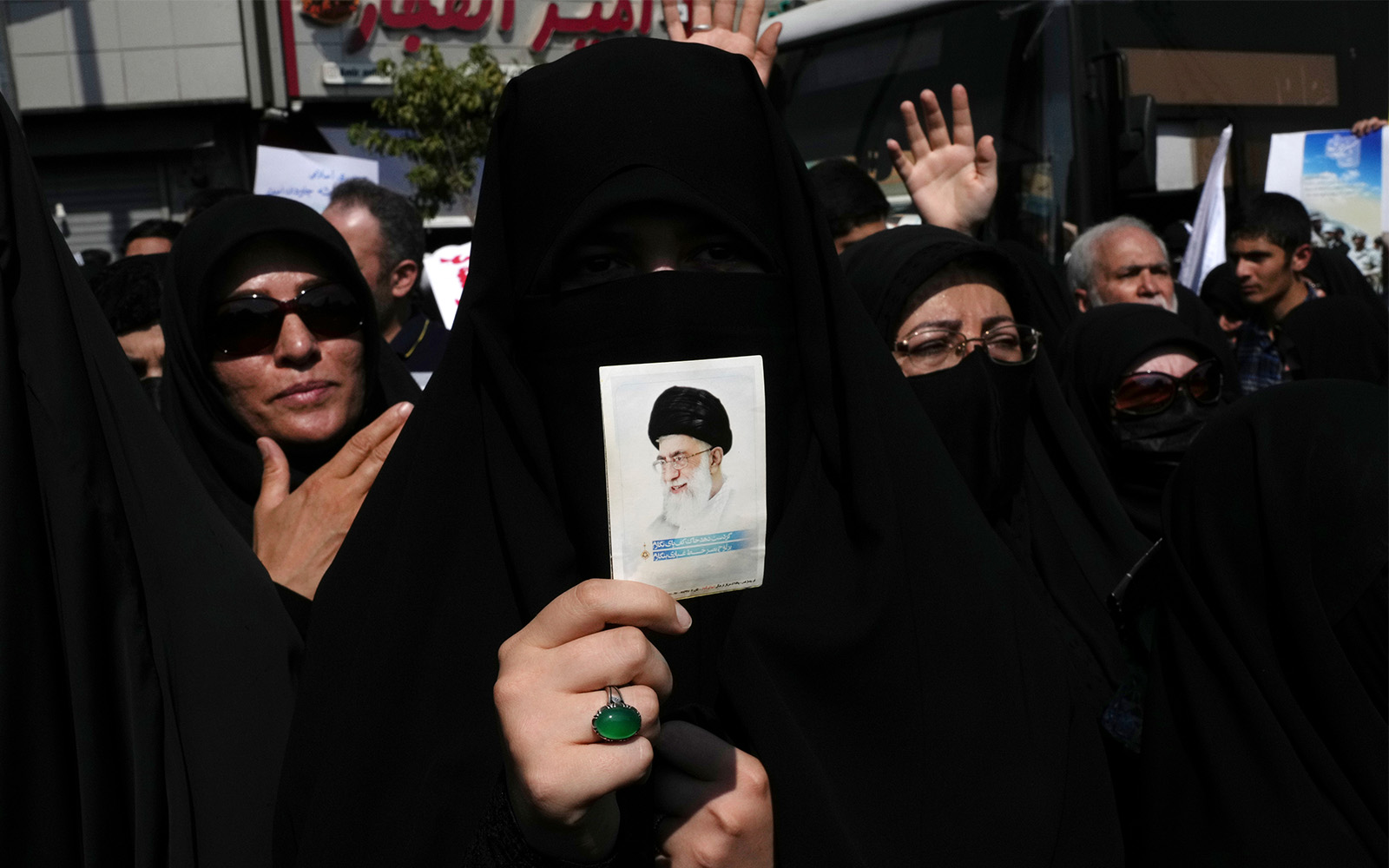
A pro-government demonstrator holds a picture of the Iranian Supreme Leader Ayatollah Ali Khamenei at a rally after Friday prayers to condemn recent anti-government protests over the death of a young woman in police custody, in Tehran, Iran, September 23, 2022. (AP Photo/Vahid Salemi)
The pro-government demonstrators chanted against America and Israel, according to state media, reflecting the official line that blames the latest unrest on hostile foreign countries.
Amini died on September 16, three days after she was hospitalized following her arrest by the morality police, the unit responsible for enforcing Iran’s strict dress code for women.
Activists said she suffered a blow to the head in custody but that has been disputed by the Iranian authorities, who have opened an investigation.
After she was pronounced dead, angry protests flared and spread to major cities, including Isfahan, Mashhad, Shiraz and Tabriz as well as her native Kurdish province.
In the latest violence, demonstrators clashed with security forces on Friday evening in the city of Bokan in West Azerbaijan province, said Hengaw, another Oslo-based rights group. The report by the organization could not be independently verified.
In the city of Babol, in northern Mazandaran province, demonstrators were seen setting ablaze a large billboard bearing the image of Iran’s supreme leader Ayatollah Ali Khamenei, in videos shared online.
Unverified footage appeared to show protesters setting fire to a base of the feared Basij militia on Ferdowsi Street in downtown Tehran.
Some women demonstrators have defiantly taken off their hijabs and burned them in bonfires or symbolically cut their hair before cheering crowds, footage showed.
Videos on social media showed protesters in Tehran torching a police car and confronting officers. Others show gunfire ringing out as protesters bolt from riot police, shouting: “They are shooting at people! Oh my God, they’re killing people!”
In the northwestern city of Neyshabur, protesters cheered over an overturned police car. Footage from Tehran and Mashhad shows women waving their obligatory headscarves, known as hijab, in the air like flags while chanting, “Freedom!”
“The government has responded with live ammunition, pellet guns and tear gas, according to videos shared on social media that have also shown protesters bleeding profusely,” the New York-based Center for Human Rights in Iran said.
Internet access has been restricted in what web monitor NetBlocks has called a “curfew-style pattern of disruptions.”
“Online platforms remained restricted and connectivity is intermittent for many users and mobile internet was disrupted for a third day on Friday,” NetBlocks said.
Authorities have tightened restrictions on popular platforms like Instagram and WhatsApp, which can be used to organize rallies.
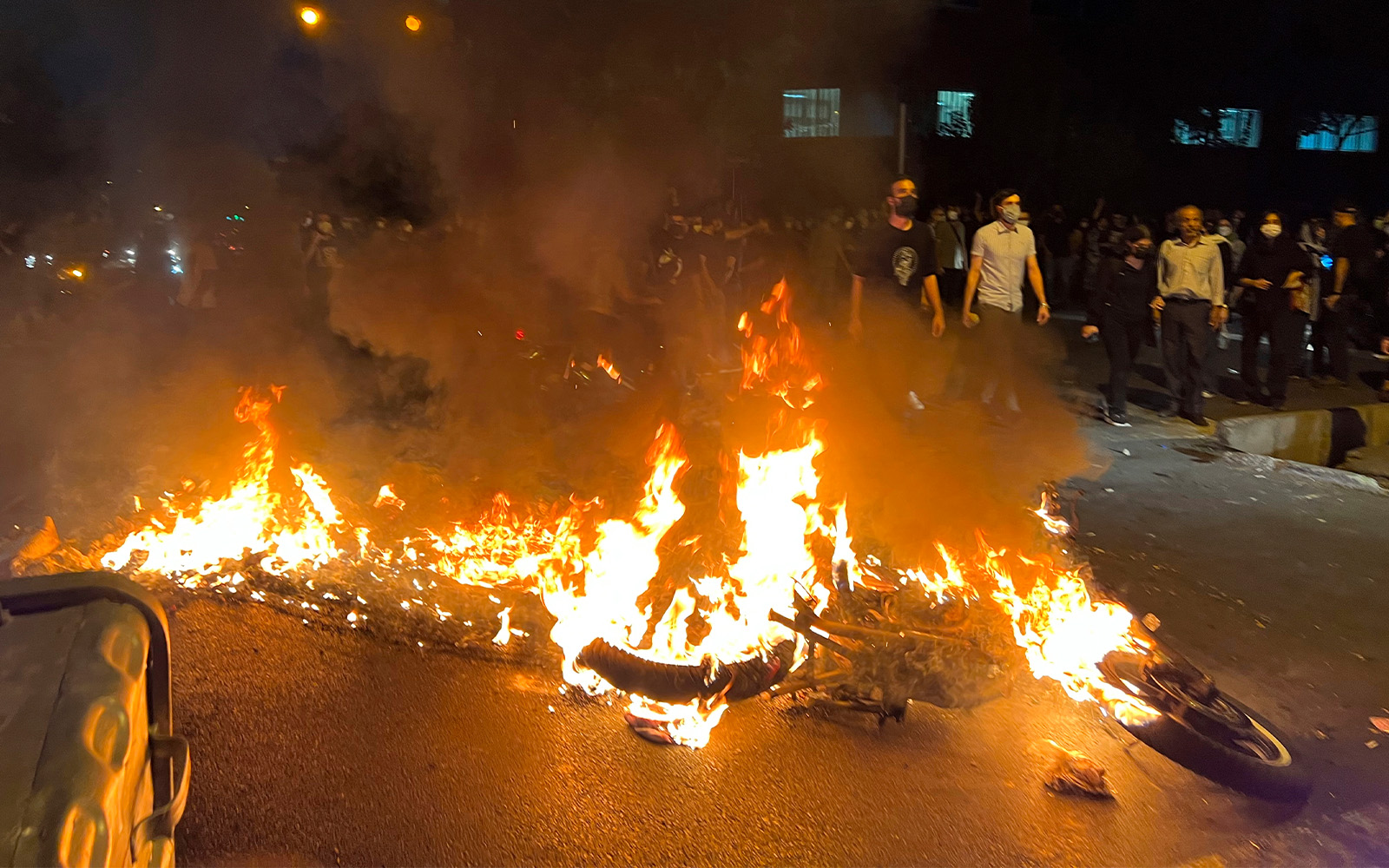
A police motorcycle burns during a protest over the death of a young woman who had been detained for violating the country’s conservative dress code, in downtown Tehran, Iran, September 19, 2022.
Measures were taken in response to “the actions carried out via these social networks by counter-revolutionaries against national security,” Iran’s Fars news agency said.
Separately, hackers have targeted a number of government websites in recent days, taking some of them down at least briefly. On Friday, hackers interrupted Iran’s Channel 3 on a popular streaming website and played videos in support of the protests. Normal programming was restored a couple of minutes later.
The protests have grown into an open challenge to the theocracy established after the 1979 Islamic Revolution. The chants have been scathing, with some chanting “Death to the dictator!” and “Mullahs must be gone!”
“The death has tapped into broader antigovernment sentiment in the Islamic Republic and especially the frustration of women,” wrote political risk firm Eurasia Group. It noted that Iran’s hard-liners have intensified their crackdown on women’s clothing over the past year since former judiciary chief Ebrahim Raisi became president.
“The prospect of the leadership offering concessions to Iranian women is minimal,” it said. “In the cold calculus of Iranian leaders, the protests have likely gone far enough and a more forceful response is required to quell the unrest.”
Raisi condemned the protests as he arrived back in Iran after addressing the United Nations General Assembly earlier this week.
“We have announced many times that if anyone has a fair comment, we will listen to it. But anarchy? Disturbing national security? The security of people? No one will succumb to this,” he said.
Iran has grappled with waves of protests in the recent past, mainly over a long-running economic crisis exacerbated by American sanctions linked to its nuclear program. In November 2019, the country saw the deadliest violence since the revolution, as protests erupted over gas price hikes.
Economic hardship remains a major source of anger today as the prices of basic necessities soar and the Iranian currency declines in value.
The Biden administration and European allies have been working to revive the 2015 nuclear accord, in which Iran curbed its nuclear activities in exchange for sanctions relief, but the talks have stalled for months. Iran has demanded a halt to United Nations nuclear inspections, a non-starter for the Western powers, stalling the negotiations.
The Eurasia Group said the protests make any immediate return to the agreement less likely, as Iran’s government will be more hesitant to make concessions at a time of domestic unrest and the United States will be reluctant to sign a deal as Iran violently cracks down on dissent.
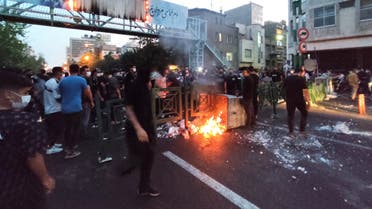
People attend a protest over the death of Mahsa Amini, a woman who died after being arrested by the Islamic republic's morality police, in Tehran, Iran September 21, 2022. (Reuters_
Jennifer Bell, Al Arabiya English
Published: 24 September ,2022
Protests have expanded in Iran as unrest triggered by the killing of Mahsa Amini by the morality police intensified, with reports of protesters storming the Basij Resistance Forces headquarters in the city of Qom and setting the building ablaze.
Al Arabiya reported on Friday that protesters have called on residents in Iran to take to the streets as videos of security forces shooting at protesters in several areas surfaced.
Al Arabiya said, quoting local media reports, that the Kurdish-majority city of Ashnawiya had also fallen to protesters.
Earlier, a Norway-based NGO confirmed on Friday that least 50 people have been killed a crackdown by the Iranian security forces on protests that erupted following the death of Amini, 22, who died last week after her arrest by the Islamic Republic’s feared morality police for allegedly wearing a hijab headscarf in an “improper” way.
The Oslo-based Human Rights Iran said the high toll came after six people were killed by security forces fire in the town of Rezvanshahr in the northern province of Gilan on Thursday evening, with other deaths recorded in Babylon and Amal (north).
There had been protests in some 80 cities and other urban centers since the demonstrations started one week ago, it added.
Rights groups have also pointed to deaths in the northern Kurdistan region where Amini was from.
“At least 50 people have been killed so far, and people continue protesting for their fundamental rights and dignity,” IHR director Mahmood Amiry-Moghaddam told AFP.
“The international community must stand by the Iranian people against one of our time's most repressive regimes,” he added.
Iran's military announced in a statement on Friday that it would "confront enemies" to ensure security and peace in the country, as protests escalated.
Issued on: 23/09/2022 -
05:15 Video by:Tom Burges WATSON
Protesters across Iran continued to clash violently with security forces early Friday following the death of a young woman in police custody, as Iranian state TV suggested the death toll from the unrest could be as high as 26, without offering details. For more on the widest unrest since 2019, FRANCE 24 is joined by Tara Kangarlou, Journalist and Professor at Georgetown University.
Issued on: 23/09/2022 -
Iranian President Ebrahim Raisi on Thursday said the death of a young woman that sparked protests in the Islamic republic needed to be investigated, but accused Western powers of hypocrisy for raising concerns.
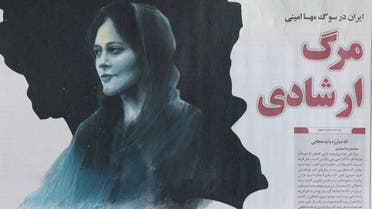
A newspaper with a cover picture of Mahsa Amini, a woman who died after being arrested by the Islamic Republic’s morality police is seen in Tehran, Iran, on September 18, 2022.
AFP, Paris
Published: 23 September ,2022:
Iranian security forces have arrested one of Iran’s most prominent civil society activists and a journalist who played a key role in exposing the case of Mahsa Amini that sparked nationwide protests, reports said Friday.
The arrests come as protests intensify over Amini, who was pronounced dead on September 16 - three days after being arrested by Tehran’s morality police, with activists saying at least 36 civilians have been killed in a police crackdown.
Majid Tavakoli, an activist who has been repeatedly imprisoned in Iran in recent years including after disputed 2009 elections, was arrested overnight at his home, his brother Mohsen wrote on Twitter.
Another prominent activist still based in Iran, Hossein Ronaghi, was giving an interview to London-based channel Iran International when security agents came to his home, the channel said.
A video published by the channel shows Ronaghi looking anxious but insisting the interview carried on.
It said the activist, who campaigns for freedom of expression, and contributes to the Washington Post, managed to escape arrest by slipping out via his building’s car park and later issued a video message from an undisclosed location.
Meanwhile Nilufar Hamedi, a Tehran journalist who went to the hospital where Amini lay in a coma and helped expose the case to the world, has been arrested, the Shargh daily newspaper, for which she works, wrote on Telegram.
Photojournalist Yalda Moaiery was this week also arrested while covering protests in Tehran, the Committee to Protect Journalists (CPJ) said Thursday.
“Iranian authorities must immediately release all journalists arrested because of their coverage of Mahsa Amini’s death and the protests that have followed,” said CPJ’s Middle East and North Africa program coordinator, Sherif Mansour.
Activists had accused the Iranian authorities of being in the throes of a crackdown even before the protests began, with two of the country’s most acclaimed filmmakers Jafar Panahi and Mohammad Rasoulof both arrested.
September 23, 2022
Agence France-Presse
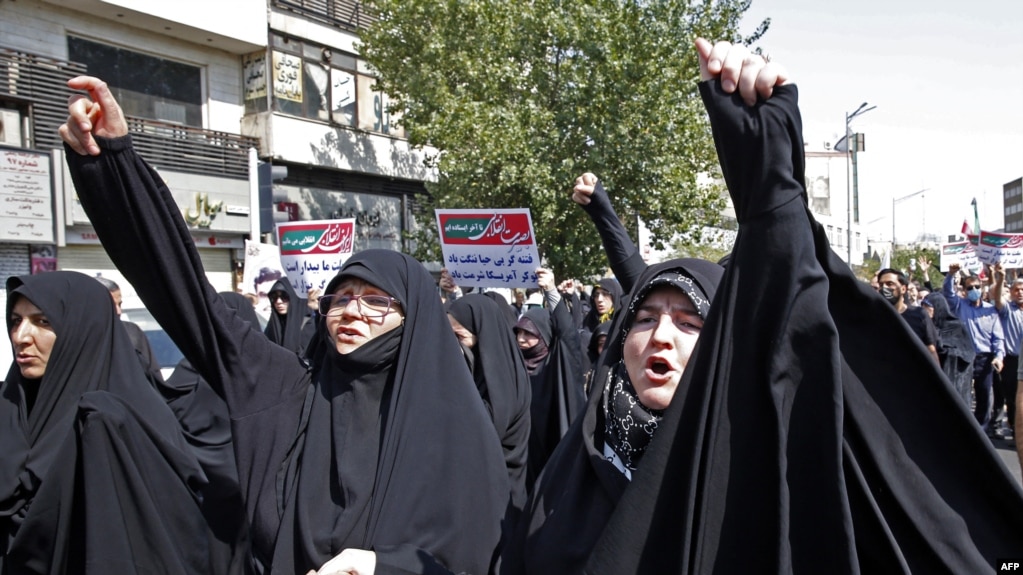
TEHRAN, IRAN —
Two Tehrans have been on show since Mahsa Amini died in morality police custody last week — the city of black-clad women castigating "improper" dress and a rival city that resents being told what to wear.
For the past week since the 22-year-old's death three days after being arrested for wearing the Islamic headscarf "improperly," protesters have taken to the streets each evening in various parts of the capital.
According to images spread on social media, female demonstrators have even taken off their headscarves and burned them in protest at the omnipresent morality police charged with enforcing the dress code Amini was alleged to have breached.
Under rules imposed shortly after the Islamic revolution of 1979, women are required to conceal their hair with a headscarf and to wear loose fitting trousers under their coats. Ripped jeans and less than full-length trousers are banned.
On Friday, outside Tehran University, supporters of the mandatory dress code gathered for a counter-rally not far from Hijab Street, one of the locations of nightly protests.

Women clad in black cloaks joined men brandishing the Islamic republic flag and placards expressing appreciation for the security forces.
"For many opponents of the morality police, the hijab issue is just a pretext to disrupt our country's security," complained the prayer leader of a nearby mosque, wearing the black turban that is the mark of a descendant of the prophet Mohammed.
"Wearing the headscarf is part of Iranians' national and religious identity," said the 40-year-old cleric, who gave only his family name Nadali.
"Certainly, the way the morality police work needs to be reviewed but it's not going to be put right by rioting."
Other demonstrators nodded their approval but when the cleric asserted that "the real Iranians are the people gathered here today," a student from the nearby polytechnic university interrupted him.
"We are all one people, one nation," retorted Hossein Zarin-Eghbal, 24, who nonetheless said he had joined the counter-demonstration in response to a call from the Islamic Development Coordination Council, one of Iran's revolutionary institutions.
"I was saddened by Mahsa Amini's death. I came to support the Islamic republic, not the morality police, because I believe that they do need to be reformed."
Burning bins
In the streets around the university, the charred remains of truck tires burned by protesters were still visible on the highway and the rubbish bins had all been removed to be set alight.
"We have a problem in this country. We have no mechanism for protest in Iran," said Zarin-Eghbal, who said he could understand the anger of his fellow citizens even though he opposed their resort to violence.
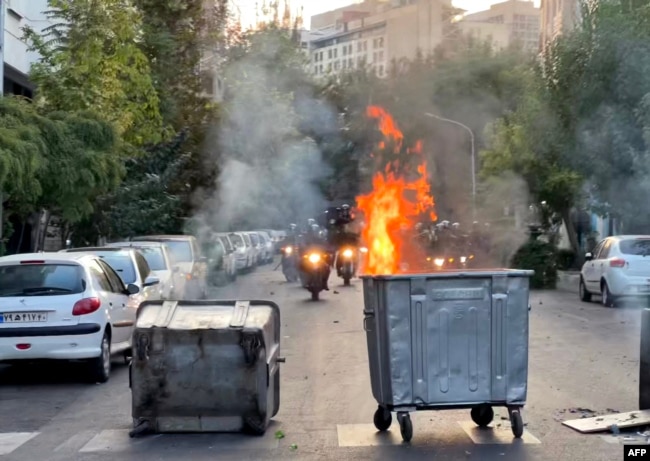
"During the 43 years of the Islamic republic, not once has the government allowed people to hold a peaceful demonstration to criticize the main tenets of the political establishment," he said.
Near Parkway Bridge, in a well-to-do Tehran neighborhood, Fatemeh, 37, said she had taken part in the protests triggered by Amini's death.
"As an Iranian woman, I don't feel safe on the streets," she said, asking to be identified by her first name only out of concern for her personal safety.
"The police frighten me when I see them and my 10-year-old daughter worries about what we're wearing around them.
"The hijab should be optional. All women should be free to wear it or not," said Fatemeh, a clothing shop manager, whose own headscarf slipped down her head repeatedly as she spoke.
"The Islamic republic, our [supreme] leader and our president should hear the people."
Stuart WILLIAMS
Fri, September 23, 2022
Iranian authorities have imposed tough and targeted restrictions on the use of the internet in a bid to impede protesters gathering and prevent images of crackdowns on their demonstrations reaching the outside world, observers say.
Activists have expressed alarm that the restrictions, also affecting Instagram which until now has remained unblocked in Iran and is hugely popular, could allow the authorities to carry out repression "under the cover of darkness".
The protests erupted a week ago over the death in Tehran of Mahsa Amini, 22, following her arrest by the notorious morality police. They first erupted in her northern home province of Kurdistan before spreading nationwide.
Internet access monitor Netblocks described the access cuts as the most "severe internet restrictions" in Iran since the deadly crackdown on protests in November 2019, when the country experienced an unprecedented near-complete internet shutdown.
It says that mobile data networks have been cut -- although there are signs of a return to connectivity -- and there have been severe regional restrictions of access to Instagram and WhatsApp.
"It's significantly different to what we saw in November 2019. It's not as near total and complete as it was back then but more sporadic," said Mahsa Alimardani, senior Iran researcher for freedom of expression group Article 19.
"But there are definitely a lot of disruptions and shutdowns happening," she told AFP, while emphasising people were still managing to connect to filtered networks through VPNs.
- 'Under cover of darkness' -
Alimardani said Iranian authorities could be wary of the effect of a total internet shutdown on the economy as well as daily life issues like online medical appointments. They were also falling back on the National Information Network, an autonomous infrastructure Iran wants to develop as a homegrown internet, she said.
She said that the restrictions had "added hurdles" to the publishing of videos of the protests but that they are "still coming out".

Videos posted on social media have included viral images of women burning their headscarves and demonstrators tearing down images of the Islamic republic's leadership, and also security forces firing on protesters.
During Iran's November 2019 protest wave sparked by a rise in fuel prices, activists argue that the internet shutdown allowed the authorities to carry out bloody repression largely hidden from the world.
Amnesty International says 321 people were killed then but it emphasises this only includes confirmed fatalities and the real toll may be much higher.
The rights group said it was now "gravely concerned about Iranian authorities disrupting access to internet and mobile networks" urging world leaders to take urgent action pressuring Iran "to stop killing and injuring more protesters under the cover of darkness."
New York-based Center for Human Rights in Iran (CHRI) director Hadi Ghaemi said that "the potential for massive bloodshed now is real".
"The government has blocked internet access because it wants to prevent people from sending evidence of the state's atrocities to the outside world," he said.
- 'Stifle free expression' -
Instagram head Adam Mosseri has expressed concern over the cuts while WhatsApp, which is also owned by social media giant Meta, insisted it was not behind any access cuts and would "do everything in our technical power to maintain our services".
Secure messaging service Signal confirmed it remained blocked in Iran and encouraged users outside to set up a proxy server to help people connect.

The blocking of major platforms by Iran in recent years -- including Facebook, Twitter, Telegram, YouTube and TikTok -- had left Instagram and WhatsApp as the two most widely used social media apps in Iran.
State media reports confirmed that officials had ordered access to the two services to be restricted.
Observers have also noted a regional targeting of the internet cuts, especially in the Kurdistan region where some of the fiercest clashes have taken place.
"Disruptions to the internet are usually part of a larger effort to stifle the free expression and association of the Iranian population, and to curtail ongoing protests," the UN's panel of human rights experts said, describing the restrictions as the third such shutdown in Iran within a year.
"State mandated internet disruptions cannot be justified under any circumstances," they added.
sjw/jh/gw
By The Associated Press

In this Wednesday, Sept. 21, 2022, photo taken by an individual not employed by the Associated Press and obtained by the AP outside Iran, protesters chant slogans during a protest over the death of a woman who was detained by the morality police, in downtown Tehran, Iran. Iranians saw their access to Instagram, one of the few Western social media platforms still available in the country, disrupted on Wednesday following days of the mass protests. (AP Photo)
DUBAI, United Arab Emirates (AP) — Clashes between Iranian security forces and protesters angry over the death of a 22-year-old woman in police custody have killed at least nine people since the violence erupted over the weekend, according to a tally Thursday by The Associated Press.
The scope of Iran’s ongoing unrest, the worst in several years, still remains unclear as protesters in more than a dozen cities — venting anger over social repression and the country’s mounting crises — continue to encounter security and paramilitary forces.
To prevent protests from spreading, Iran’s biggest telecom operator largely shut down mobile internet access again Thursday, said Netblocks, a group that monitors internet access, describing the restrictions as the most severe since 2019.
An anchor on Iran’s state television suggested the death toll from the mass protests could be as high as 17 on Thursday, but did not say how he reached that figure.
In a country where radio and television stations already are state-controlled and journalists regularly face the threat of arrest, the paramilitary Revolutionary Guard urged the judiciary on Thursday to prosecute “anyone who spreads fake news and rumors” on social media about the unrest. Widespread outages of Instagram and WhatsApp, which are used by protesters, also continued Thursday.
WhatsApp tweeted that it was “working to keep our Iranian friends connected and will do anything within our technical capacity to keep our service up and running.”
The demonstrations in Iran began as an emotional outpouring over the death of Mahsa Amini, a young woman held by the country’s morality police for allegedly violating its strictly enforced dress code. Her death has sparked sharp condemnation from the United States, the European Union and the United Nations.
The U.S. government imposed sanctions on the morality police and leaders of other Iranian security agencies, saying they “routinely employ violence to suppress peaceful protesters.”
Iranian police say Amini died of a heart attack and was not mistreated, but her family has cast doubt on that account. Independent experts affiliated with the U.N. said Thursday that reports suggested she was severely beaten by the morality police, without offering evidence.
In New York, on the sidelines of the U.N. General Assembly, Iranian President Ebrahim Raisi said the death must be “steadfastly” investigated. But he also turned the tables on the country he was visiting for the U.N. General Assembly.
“What about the death of Americans at the hands of U.S. law enforcement?” Raisi asked about his country’s rival nation. He called for the “same standard” around the world in dealing with such deaths at the hands of authorities and lamented what he said were “double standards” in the West.
Of Amini’s death, he said authorities were doing what they needed to do. “It must certainly be investigated,” he said. “I contacted her family at the very first opportunity and I assured them we would continue steadfastly to investigate that incident. ... Our utmost preoccupation is the safeguarding of the rights of every citizen.”
Niloufar Hamedi, a journalist who took photographs at the hospital after Amini’s death, was arrested in Iran on Thursday, according to the reporter’s lawyer, Mohammadali Kamfirouzi. He said her house was raided. There was no official comment.
The protests have grown in the last five days into an open challenge to the government, with women removing and burning their state-mandated headscarves in the streets and Iranians calling for the downfall of the Islamic Republic itself.
“Death to the dictator!” has been a common cry in the protests.
They are the most serious demonstrations since 2019, when protests erupted over a government hike in the price of gasoline. Rights groups say hundreds were killed in the crackdown that followed, the deadliest violence since the 1979 Islamic Revolution.
The latest protests are similarly widespread, but seem to have much broader support among the population, with Iranians of all walks of life expressing fury at Amini’s death and the government’s treatment of women.
Iran’s state-run media this week reported demonstrations in at least 13 cities, including the capital, Tehran. Videos online show security forces firing tear gas and water canons to disperse hundreds of protesters. London-based Amnesty International reported that officers also fired birdshot and beat protesters with batons.
Footage on social media from the northern city of Tabriz shows a young man allegedly shot by security forces bleeding out in the street as protesters shout for help.
Another video showed a policeman firing a shotgun at a demonstrator who was tearing down a pro-government billboard in the North Khorasan province. It’s unclear if he was wounded.
In another video, protesters can be seen torching a massive billboard showing Qassem Soleimani — Iran’s top general who was killed in a U.S. airstrike — in his hometown of Kerman. Soleimani has iconic status among government supporters.
At least nine people have died in the confrontations, according to an AP count based on statements from Iran’s state-run and semiofficial media. In a statement on Thursday, the Guard blamed the unrest on “Iran’s enemies.”
In Amini’s home province of Kurdistan, the provincial police chief said four protesters were shot dead. In Kermanshah, the prosecutor said two protesters were killed, insisting that the bullets were not fired by Iran’s security forces.
Three men affiliated with the Basij, a volunteer force under the Guard, were killed in clashes in the cities of Shiraz, Tabriz and Mashhad, semiofficial media reported, bringing the death toll acknowledged by officials to at least nine on both sides.
In the northern province of Mazandaran, angry crowds damaged or set fire to over 40 government properties and wounded 76 security officers, Rouhollah Solgi, the deputy governor, said.
Iran has grappled with waves of protests in the recent past, mainly over a long-running economic crisis exacerbated by Western sanctions linked to its nuclear program. Citizens also blame government corruption and mismanagement.
The Biden administration and European allies have been working to revive the 2015 Iran nuclear accord, in which Iran curbed its nuclear activities in exchange for sanctions relief, but the talks have been deadlocked for months.
From New York, where Raisi took the stage Wednesday at the U.N. General Assembly, CNN’s chief international anchor Christiane Amanpour said she had planned to confront Raisi about the protests in what would be his first U.S.-based interview.
But Amanpour wrote on Twitter that Raisi was a no-show. An aide told her the president refused to take part unless she wore a headscarf, given the “situation in Iran.” The Iranian government has not commented on the incident.
“I couldn’t agree to this unprecedented and unexpected condition,” the British-Iranian anchor wrote beside a photo of Raisi’s empty chair.


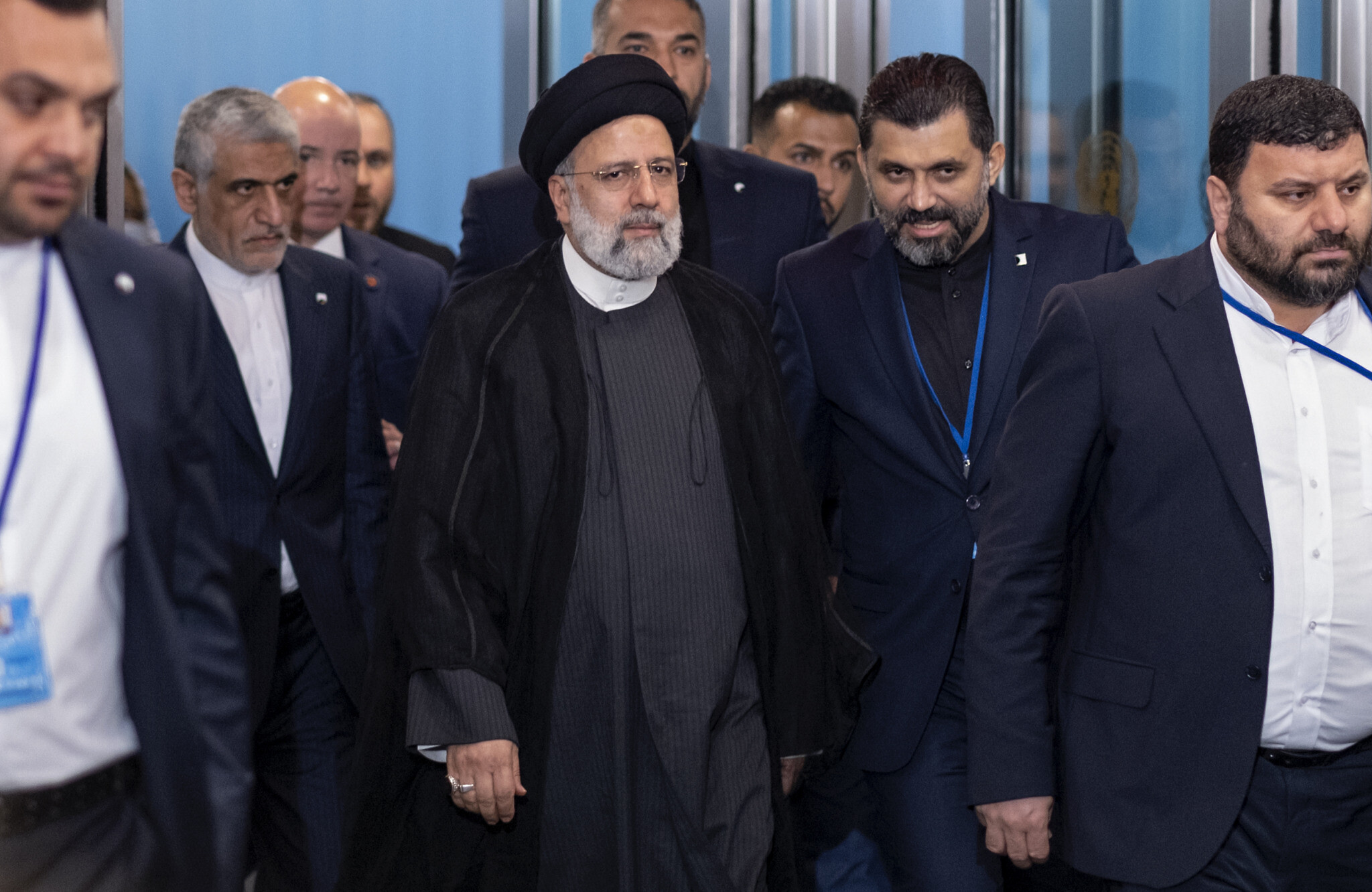
No comments:
Post a Comment